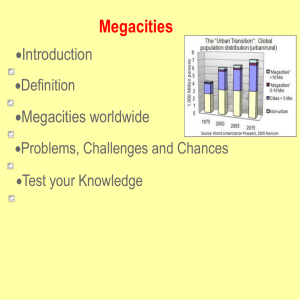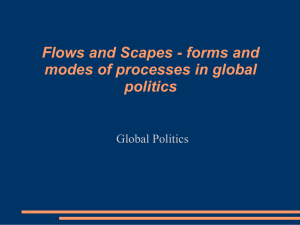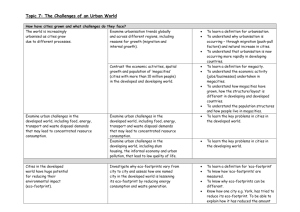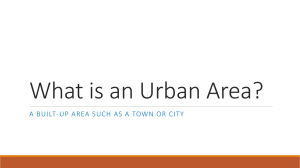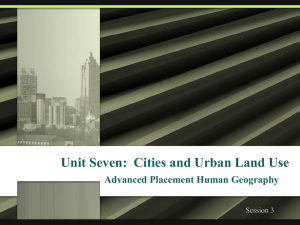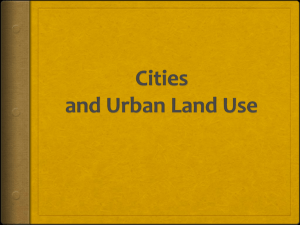Sustainable Development in Megacities Mediterranean Journal of Social Sciences Saeed Nasiri Majd
advertisement
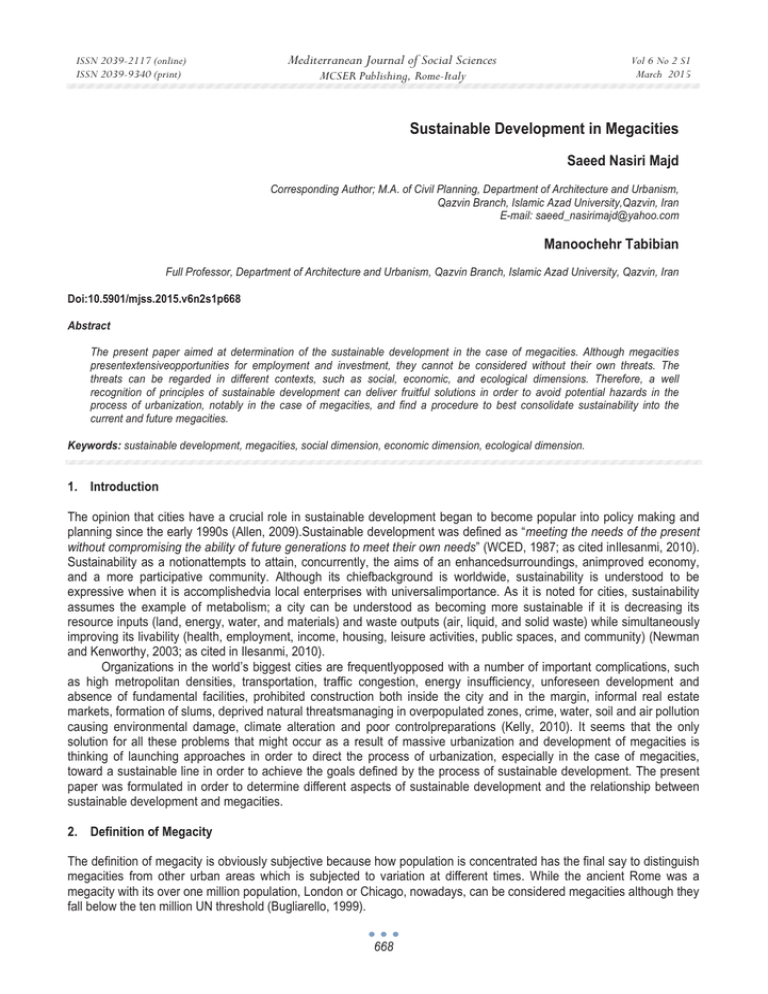
ISSN 2039-2117 (online) ISSN 2039-9340 (print) Mediterranean Journal of Social Sciences Vol 6 No 2 S1 March 2015 MCSER Publishing, Rome-Italy Sustainable Development in Megacities Saeed Nasiri Majd Corresponding Author; M.A. of Civil Planning, Department of Architecture and Urbanism, Qazvin Branch, Islamic Azad University,Qazvin, Iran E-mail: saeed_nasirimajd@yahoo.com Manoochehr Tabibian Full Professor, Department of Architecture and Urbanism, Qazvin Branch, Islamic Azad University, Qazvin, Iran Doi:10.5901/mjss.2015.v6n2s1p668 Abstract The present paper aimed at determination of the sustainable development in the case of megacities. Although megacities presentextensiveopportunities for employment and investment, they cannot be considered without their own threats. The threats can be regarded in different contexts, such as social, economic, and ecological dimensions. Therefore, a well recognition of principles of sustainable development can deliver fruitful solutions in order to avoid potential hazards in the process of urbanization, notably in the case of megacities, and find a procedure to best consolidate sustainability into the current and future megacities. Keywords: sustainable development, megacities, social dimension, economic dimension, ecological dimension. 1. Introduction The opinion that cities have a crucial role in sustainable development began to become popular into policy making and planning since the early 1990s (Allen, 2009).Sustainable development was defined as “meeting the needs of the present without compromising the ability of future generations to meet their own needs” (WCED, 1987; as cited inIlesanmi, 2010). Sustainability as a notionattempts to attain, concurrently, the aims of an enhancedsurroundings, animproved economy, and a more participative community. Although its chiefbackground is worldwide, sustainability is understood to be expressive when it is accomplishedvia local enterprises with universalimportance. As it is noted for cities, sustainability assumes the example of metabolism; a city can be understood as becoming more sustainable if it is decreasing its resource inputs (land, energy, water, and materials) and waste outputs (air, liquid, and solid waste) while simultaneously improving its livability (health, employment, income, housing, leisure activities, public spaces, and community) (Newman and Kenworthy, 2003; as cited in Ilesanmi, 2010). Organizations in the world’s biggest cities are frequentlyopposed with a number of important complications, such as high metropolitan densities, transportation, traffic congestion, energy insufficiency, unforeseen development and absence of fundamental facilities, prohibited construction both inside the city and in the margin, informal real estate markets, formation of slums, deprived natural threatsmanaging in overpopulated zones, crime, water, soil and air pollution causing environmental damage, climate alteration and poor controlpreparations (Kelly, 2010). It seems that the only solution for all these problems that might occur as a result of massive urbanization and development of megacities is thinking of launching approaches in order to direct the process of urbanization, especially in the case of megacities, toward a sustainable line in order to achieve the goals defined by the process of sustainable development. The present paper was formulated in order to determine different aspects of sustainable development and the relationship between sustainable development and megacities. 2. Definition of Megacity The definition of megacity is obviously subjective because how population is concentrated has the final say to distinguish megacities from other urban areas which is subjected to variation at different times. While the ancient Rome was a megacity with its over one million population, London or Chicago, nowadays, can be considered megacities although they fall below the ten million UN threshold (Bugliarello, 1999). 668 ISSN 2039-2117 (online) ISSN 2039-9340 (print) Mediterranean Journal of Social Sciences MCSER Publishing, Rome-Italy Vol 6 No 2 S1 March 2015 Megacities mostly appear because of consolidation of a few settlement points (e.g. Tokyo). A megacity can also be developedfrom a single, quickly-growing urban canter. This can be considered for the situations in which clear sorts of developments are situated at the margin of the urban center. As other developments are persistently involved in the margin, the specific urban center develops leading to formation of a megacity (Labisi, 2012). Megacities deliver widespread chances for occupation and investment. The accumulation of people similarly allows the probability for a well-organized and sustainable administration of capitals as a result of lower expenses per capita for e.g. the provision of piped water or the collection and disposal of garbage (Satterthwaite 1999; as cited in Heinrichs et al. 2007). Furthermore, the urban centers provide the social capitals as well as the human and the economicwealth in order to cope withinternational challenges. Alternatively, megacitiesfocus natural, ecological, social, and financialhazards. Megacities not only experience such risks themselves but also cause and increase these hazards (Heinrichs et al. 2007). Megacities are a result of the continuing urbanization. A megacity is typically distinct as a municipal zone with an entire population over 10 million people. Megacities may be recognized from global cities by their swiftdevelopment, novel forms of spatial population density, and both formal and informal economy, in addition to poverty, crime, and high levels of social disintegration. A megacity can be a solitaryurbanzone or two or more metropolitan zones that come together (Mavropoulos, 2010). Mega cities are not just cities with abigextent. They are a novel, characteristic spatial form. They have a robustinteriorconsistency. The purposes and actionsachieved in their ground are spatially interrelated. They are not anassociation of diversezones, even though we can distinguishsystematically spatial subunits. They are one solitaryzone in a very important sense: they establish a compoundelement of production, a single workarcade and a preciseorganization of control, outside their extreme cultural and social diversity. Their ground, even though it has massive size, is utilizedregularly by a lot of people inside the limits of the megacity (Castells, 1993). Megacities have a robustinteriorconsistency. They are not anassociation of diversezones. Most often they are essentially one single part. They comprise a compound unit of production for consumption, a large labor market, anexplicit system of control and extreme social and cultural discrepancy. Purposes and activities achievedinside their grounds are spatially interrelated. Their areas are adopted daily by millions of people inside its limits(Castells 1993; as cited in Phdungsilp, 2006). 3. Different Dimensions of Sustainable Development 3.1 Social dimension Social dimensions of sustainable development in megacities can be explored in population growth rate, population density, life expectancy rate, immigration rate (migration from rural areas and immigration), at-risk-of-poverty rate, social polarization rate, inequality rate of income distribution, crime rate, dimension of housing shortages; ghettos, slums, squatters, unemployment rate, and rate of people with unhealthy living conditions (Kötter and Friesecke, 2004).Social sustainability denotes the equality, comprehensiveness and cultural competence of an intermediation to encourage equal rights over the natural, physical and economic wealth that supports the livings and lives of local societies, with specifichighlightingof the poor and conventionallysidelinedclusters. Cultural competence meansthe degree to which a practice relates to cultural tradition and cultural variety (Allen, 2009). 3.2 Economic dimension Economic dimensions of sustainable development in megacities can be discovered in development of the local economy/economic structure, real GDP growth rate, unemployment rate, accessibility of public transportation infrastructure, quality of transportation network, infrastructure deficiencies; overtaxed infrastructures, risk of economic loss in case of a disaster(Kötter and Friesecke, 2004). As management thinkers have suggested the only success factor for organizations in the information age are employees and managers. the industry has developed (Gilaninia et al., 2011) Economic sustainability is assumed as the volume and capability of a practice in order to put native and regional capitals to fruitful use for the long-term advantage of the community, without destructing or exhausting the natural reserve and without increasing the city’s ecological impression. This indicates considering the complete influence of the production sequence (Allen, 2009). Customer satisfaction is a substantial issue in relationship marketing, particularly those in services industries (Gilaninia et al, 2012) 669 ISSN 2039-2117 (online) ISSN 2039-9340 (print) Mediterranean Journal of Social Sciences MCSER Publishing, Rome-Italy Vol 6 No 2 S1 March 2015 3.3 Ecological dimension Economic dimensions of sustainable development in megacities can be revealed inair pollution from vehicle emissions, industry etc., groundwater and drinking water pollution, quality of sewage treatment, capacities of waste collection and disposal services, land sealing rate, suburbanization (urban sprawl) rate, number and dimension of brownfields, destruction of original vegetation; deforestation; damage to flora, fauna, biodiversity per year, risks to natural disasters or industrial accidents(Kötter and Friesecke, 2004). Ecological sustainability relates to the influence of urban production and consumption on the reliability and well-being of the city area and worldwide carrying volume. This requires the long term consideration of the relationship between the state and dynamics of ecological capitals and services (Allen, 2009). Allen (2009) also considers two more dimensions of social sustainability. The sustainability of the built environment relates to the capacity of an intermediation to improve the performance of structures and urban substructures for all inhabitants without destructing or upsetting the urban area environment. It similarly comprises a worry for the competence of the constructed environment to care for the local economy. Furthermore, political sustainability is associated with the superiority of authority systems directing the connection and actions of diverse performers among the above-mentioned dimensions. Thus, it suggests the democratization and contribution of local public society in all parts of decision-making. 4. Sustainability of Megacities Various factors should be considered when considering sustainability in mega cities. One of the most important dimensions of sustainability in megacities in environment. Environment in megacities development has been neglected due to achieving higher economic profit. That’s why a huge body of environmental resources have been destroyed and exhausted because of not considering sustainable development principles while developing megacities. Therefore, for achieving a sustainable management of environmental development in megacities, new ways should be found in order to best integrate environment into urban development. Another distinctive feature of sustainable megacities is the vivid difference between the definition of “growth” and “development”. Growth has just a solid meaning pertaining to only obtaining higher gain of the property while development can be considered to have a wiser definition which involves a balance between various aspects of any movement toward expansion. In fact, in sustainability of development, the most important factor is the precise balance of the inputs and outputs in order to achieve higher profit without wasting capitals. Better coordination of transport, land use and open space planning, development of a green compact city, preservation of blue and green infrastructure, and promotion of local production are among the approaches which have been recognized as significant phases of more sustainable development of megacities (Nilsson et al. 2014). The challenge of realizing the objective of a sustainable city is not a technicalissue, but it requires analteration in government, economics, and social relationships, in addition to an incorporation of these characteristics into the organization (Hopwood 2001; as cited inPhdungsilp, 2006). The sustainable city comprisesacohesive arrangement of harmonization between organizations, and developmental actionsassociated with a generalattitude in its design and administration. Hitherto, strategiestrying to implement the conceptions of sustainability inside a city have not gone far sufficiently into the origin of the matter. In order to attain this it would needconsiderablevariations in the administrativeprocedure of decision-making regarding both social and economic strategies. Megacities already characterize extreme exhibitions of the urbanization outline. Nevertheless, megacities remain on growing line, both in their extent and in their attraction as a setting for the lives and purposes of a population. The objective of attaining sustainability is worth to try for and needs a persistence of the current small phases, in addition to the combination of bigsteps (Phdungsilp, 2006). 5. Conclusion The present study attempted to bring principles of sustainable development into appearance of megacities in order to address the areas of work for the future of megacities. Addressing the potential hazards threatening the megacities and their surroundings can be of a great amount of importance as it can display frameworks to improve megacities in the context of sustainable development. However, the issue of sustainability cannot be regarded as a single issue to inject into megacity planning and attain favorable results. Therefore, considering various aspects, as called dimensions in the present study, is an inevitable requirement in any effort for consolidation of sustainability into designing future megacities. 670 ISSN 2039-2117 (online) ISSN 2039-9340 (print) Mediterranean Journal of Social Sciences MCSER Publishing, Rome-Italy Vol 6 No 2 S1 March 2015 References Allen, A. (2009). Sustainable citiesor sustainableurbanisation?; Taken from the Summer 2009 edition of ‘palette’, UCL’s Jurnal of Sustainable Cities. Bugliarello, G. (1999). Megacities and the developing world; The Bridge, Vol. 29, No. 4, pp. 19-26. Castells M. (1993), Why the Mega-Cites Focus: Mega-cites in the New World Disorder.Mega-Cities 7th Annual Coordinators Meeting, August 1-7, 1993, Jakarta, Indonesia. Gilaninia,Sh; Mousavian,S.J; Tayebi,F; Panjtan Panah,M;Ashouri,S;Touhidi,R; Nobahar,R; Azizi,N. (2011). The Impact of Information Technology Application on Supply Chain Performance, Interdisciplinary Journal of Contemporary Research In Business, VOL 3, NO 8,pp 489-496. Gilaninia,Sh;Mousavian,S.J; Salimi,M.A; Azizzadeh,A; Makarehchian,A.(2012). Economic Growth in Iran and Effective Factors on Its Changes, J. Basic. Appl. Sci. Res., 2(2)986-994. Heinrichs, D., Nuissl, H., Stelzer, V. (2007). Risk Habitat Megacity - Strategies for Sustainable Development in Megacities and Urban Agglomerations; Forum DKKV/CEDIM: Disaster Reduction in Climate Change, Karlsruhe University. Hopwood B. (2001). Sustainable Cities: Phrases or Practice? The 31st International MakingCities Liveable Conference, San Francisco, USA. Ilesanmi, A.O.(2010). Urban sustainability in the context of Lagos mega-city; Journal of Geography and Regional Planning, Vol. 3(10), pp. 240-252. Kelly, P. (2010). Managing Megacities: A Spatial Solution; FIG Publication No 48, pp. 1-15. Kötter, T., Friesecke, F. (2004). Developing urban Indicators for Managing Mega Cities; Conference on Land Governance in Support of the MDG's: Responding to New Challenges. Labisi, A. (2012). Lagos megacity or mega-slum? Towards a sustainable Lagos megacity development: some basic planning considerations; Journal of Sustainable Development in Africa, Vol. 14, No. 6, pp. 145-159. Mavropoulos, A. (2010). Megacities Sustainable Development and Waste Management in the 21st Century, Hamburg: ISWA Conference. Newman, P., Kenworthy, J. (2003). Sustainability and cities: summary and conclusions; In Cuthbert AR (ed.) Designing Cities: Critical Readingsin Urban Design. Oxford: Blackwell. pp. 235-242. Nilsson, K. et al. (2014). Strategies for Sustainable Urban Development and Urban-Rural Linkages; Research briefings, European Journal of Spatial Development. Phdungsilp, A.(2006). Energy Analysis for SustainableMega-Cities; Licentiate ThesisSchool of Industrial Engineering and ManagementDepartment of Energy TechnologyRoyal Institute of Technology Satterthwaite, D. (1999). The Earthscan Reader in Sustainable Cities. London: Earthscan. World Commission on Environment and Development (1987). OurCommon Future, Oxford: Oxford University Press. 671
